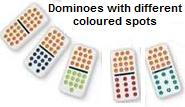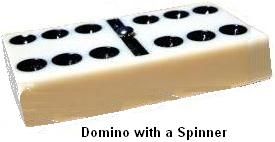|
||||||||||||||||||||||||||||||||||||||||||||||||||||||||||||||||||||||||||||||||||||||||||||||||
|
|
||||||||||||||||||||||||||||||||||||||||||||||||||||||||||||||||||||||||||||||||||||||||||||||||
|
General Western Domino Attributes Western style double-square dominoes, like the standard Double-Sixes through to the less common Double-Eighteens, will all have some common attributes and features associated with them. The common standard Western domino sets found today may come marked with a differing number of spots and have a varying number of tiles, but all these sets have some common attributes and features. Each tile in any Western domino set is twice as long as it is wide, and so is known as a "double-square". The tiles are divided in half, widthways, by a centrally marked line (known as a bar, divider, or centre), with each end, either side of the dividing line, bearing one of a number of suits. Suits are marked on the tile as a number of spots (or pips) ranging from 0 (none or blank) up to possibly as many as eighteen, depending on the type and size of domino set. Domino Spots Originally, domino spots where made
of inlaid black ebony set into a white bone or ivory base. The
most common colour used in the majority of domino spots you may
come across will be black. However, white spots set into a
black or dark base material are also manufactured and aren't uncommon. A more
recent development is the use of coloured spots, often with different
colours used for Domino Sizes Dominoes can come in a variety of different sizes to suit a player's own personal taste and preference. their products.Here is a table of the dimensions used for the most common sizes of domino you may come across, although this table doesn't cover the whole range you could possibly find.
When it comes to deciding on the best size of domino to suit you, you will have to consider a number of factors. For example: The games you want to play, and the area of the flat surface where you will be playing. If you only have a very small table to play on, then a mini-sized set may be preferential, but if space isn't an issue then the larger sets are much easier to read and handle, and may be considered preferential generally. In some domino games, players hold their dominoes in their hand, like a hand of playing cards, and the larger dominoes may prove very awkward and clumsy to hold. Other domino games are played with player's hands of tiles laying on their side's edge, facing the player. Thicker tiles are obviously better suited for this and are a lot less likely to fall over if jogged or should the playing surface be accidentally disturbed. Domino SpinnersDominoes can be made of two distinctly separate layers (often one ebony and the other ivory), and a small metal pin called a "spinner" was used to hold the two layers together. You may still find a spinner in some modern dominoes, that aren't made of two separate layers, possibly out of respect for tradition, but also because the spinner usefully protects the domino's face when being shuffled, and because it is easier to rotate (or spin) and generally manipulate the tile when placing it in position during a game. The spinner is sometimes also known as a "pivot".
Spinners are not found in Chinese
dominoes, because they would prevent the domino tiles being
squarely stacked. More... Here is a rather complex formula for calculating the number of tiles in any Western double-square domino set. " n" is the highest numbered spotted end of a tile in the domino set: 6 for a Double-Six set; 12 for a Double-Twelve set.
Total number of tiles in a set = ((n2
+ (3 × n) + 2) ÷ 2)
Here is a different formula for calculating the number of spots (or pips) in a domino set.
Total number of spots in a set = ((n3)
÷ 2) + ((3
× n2)
÷ 2) + n
This can be more easily expressed as: Total number of spots in a set = number of tiles × n To save you the trouble of actually using these formulas, here is a table listing all the double-square domino sets' tile and spot counts.
Dominoes Marked With Numerals Double-square dominoes aren't always conventionally marked with spots (or pips). There are many sets of dominoes manufactured that are marked with numbered numerals to denominate the different suits on either end. For more details on these dominoes, try clicking on the link below...
|
|||||||||||||||||||||||||||||||||||||||||||||||||||||||||||||||||||||||||||||||||||||||||||||||
|
Copyright © 2016 Stormdark I.P. and Media. All rights reserved. www.domino-play.com This site is for personal use only and content may not be copied or reproduced in any form for any purpose. Terms & Conditions Advertising |
||||||||||||||||||||||||||||||||||||||||||||||||||||||||||||||||||||||||||||||||||||||||||||||||

 different suits making it easier to match them with one another.
Coloured spots are more common with the larger domino sets where the suit
of a tile is less easily recognised. The spots will be set into the
face of the tile, either by drilling shallow holes into the tile's surface
or with indentations made when molding the domino tile.
different suits making it easier to match them with one another.
Coloured spots are more common with the larger domino sets where the suit
of a tile is less easily recognised. The spots will be set into the
face of the tile, either by drilling shallow holes into the tile's surface
or with indentations made when molding the domino tile. If a domino has a spinner, it will be located in the
centre of the tile through the middle of its central dividing bar.
It is often manufactured out of brass or possibly another metal and will
be rounded off to prevent scratching and damaging the playing surface
If a domino has a spinner, it will be located in the
centre of the tile through the middle of its central dividing bar.
It is often manufactured out of brass or possibly another metal and will
be rounded off to prevent scratching and damaging the playing surface